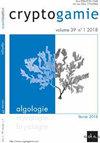A Critical Review of Cyanobacteria Distribution and Cyanotoxins Occurrence in Atlantic Ocean Islands
IF 1.5
4区 生物学
Q3 MARINE & FRESHWATER BIOLOGY
引用次数: 6
Abstract
ABSTRACT Cyanobacteria are diverse, complex and a unique group of microorganisms that inhabit a wide variety of environments. Contrarily to continental areas, studies on cyanobacteria in islands are scarce and need to be reinforced, since climate change impacts are expected to be harsher in islands, due to their geographical isolation and higher exposition to external influences. Here we present a review of the occurrence of cyanobacteria and cyanotoxins in inland and coastal ecosystems in the Atlantic Ocean islands. These microorganisms were reported from diverse habitats, including saline thermal lakes (Iceland), freshwater lakes, terrestrial habitats (Azores, Cuba), and marine coastal areas, either planktonic (Madeira, Canary Islands, Cape Verde) or associated to plants and corals (Brazil, Caribbean Sea). Most of cyanobacteria were reported from freshwaters but some species were found in different habitats. Species richness also varied between islands, with higher number in islands located in temperate regions, and the number of common taxa was low (1-3%). Several toxic species and different types of cyanotoxins were also reported in the Atlantic islands, which are expected to increase with climate change. Mitigation measures should be considered to avoid cyanotoxins risks to environmental and public health. This works shows the great potential of Atlantic islands for cyanobacteria taxonomic, ecological and biogeography research, but more studies are needed with emphasis on less studied islands and habitats and using novel approaches as molecular systematics tools. Furthermore, such studies are of paramount importance for environmental conservation and management strategies, especially facing climate changes.大西洋岛屿蓝藻菌分布和蓝藻毒素的研究进展
蓝藻是多样的,复杂的和独特的一组微生物,栖息在各种各样的环境。与大陆地区相反,对岛屿上蓝藻的研究很少,需要加强,因为岛屿由于地理隔离和更容易受到外部影响,预计气候变化的影响将更严重。在这里,我们提出了蓝藻和蓝藻毒素在大西洋岛屿内陆和沿海生态系统的发生审查。据报道,这些微生物来自不同的栖息地,包括咸水热湖(冰岛)、淡水湖、陆地栖息地(亚速尔群岛、古巴)和海洋沿海地区,要么是浮游的(马德拉群岛、加那利群岛、佛得角),要么是与植物和珊瑚有关的(巴西、加勒比海)。据报道,大多数蓝藻来自淡水,但也有一些物种存在于不同的栖息地。物种丰富度在岛屿之间也存在差异,温带岛屿的物种丰富度较高,常见分类群的数量较低(1-3%)。在大西洋岛屿上也报告了几种有毒物种和不同类型的蓝藻毒素,预计随着气候变化会增加。应考虑采取缓解措施,以避免蓝藻毒素对环境和公众健康构成风险。这项工作表明大西洋岛屿蓝藻分类学,生态学和生物地理学研究的巨大潜力,但需要更多的研究,重点是研究较少的岛屿和栖息地,并使用新的方法作为分子系统学工具。此外,这些研究对环境保护和管理战略至关重要,特别是面对气候变化。
本文章由计算机程序翻译,如有差异,请以英文原文为准。
求助全文
约1分钟内获得全文
求助全文
来源期刊

Cryptogamie Algologie
生物-海洋与淡水生物学
CiteScore
2.60
自引率
7.70%
发文量
11
审稿时长
>12 weeks
期刊介绍:
Cryptogamie is a fast-track and peer-reviewed journal of international scope publishing in English only. It accepts original papers and review articles on the taxonomy, biology and ecology of all cryptogams. An issue of Cryptogamie may be devoted to a single topic, under the responsibility of guest editor(s). All articles published in Cryptogamie are compliant with the different nomenclatural codes. A copyright assignment will be signed by the authors before publication.
Cryptogamie, Algologie accepts articles on systematics as well as ecology and evolution of any kind of algae (including Cyanobacteria).
 求助内容:
求助内容: 应助结果提醒方式:
应助结果提醒方式:


